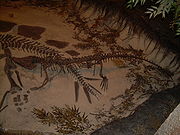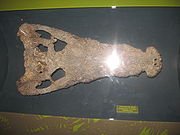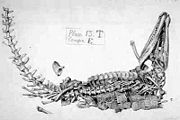
Goniopholis
Encyclopedia
Goniopholis is an extinct genus
of crocodyliform that lived in North America
, Europe
and Asia
during the Late Jurassic
and Early Cretaceous
. Being semi-aquatic it is very similar to modern crocodiles. It ranged from 2–4 metres in length, and would have had a very similar lifestyle to the American alligator
or Nile crocodile
.
Goniopholis was closely related to the ancestor of extant crocodilians.


 Many species of Goniopholis have been described, G. crassidens lived during the Early Cretaceous (Berriasian
Many species of Goniopholis have been described, G. crassidens lived during the Early Cretaceous (Berriasian
) of England. Goniopholis simus is from the Early Cretaceous of NW Germany; G. gilmorei and G. stovalli are from the Late Jurassic of North America, while G. baryglyphaeus is known from the Late Jurassic (Kimmeridgian
) of Portugal making it the oldest known Goniopholis species. Other Late Jurassic species such as, G. phuwiangensis is known from NE Thailand, and G. lucasii from the Tithonian
of Colorado (although may belong to a different genus, Amphicotylus). Nannosuchus gracilidens from the Early Cretaceous of England is a juvenile Goniopholis.
Genus
In biology, a genus is a low-level taxonomic rank used in the biological classification of living and fossil organisms, which is an example of definition by genus and differentia...
of crocodyliform that lived in North America
North America
North America is a continent wholly within the Northern Hemisphere and almost wholly within the Western Hemisphere. It is also considered a northern subcontinent of the Americas...
, Europe
Europe
Europe is, by convention, one of the world's seven continents. Comprising the westernmost peninsula of Eurasia, Europe is generally 'divided' from Asia to its east by the watershed divides of the Ural and Caucasus Mountains, the Ural River, the Caspian and Black Seas, and the waterways connecting...
and Asia
Asia
Asia is the world's largest and most populous continent, located primarily in the eastern and northern hemispheres. It covers 8.7% of the Earth's total surface area and with approximately 3.879 billion people, it hosts 60% of the world's current human population...
during the Late Jurassic
Late Jurassic
The Late Jurassic is the third epoch of the Jurassic Period, and it spans the geologic time from 161.2 ± 4.0 to 145.5 ± 4.0 million years ago , which is preserved in Upper Jurassic strata. In European lithostratigraphy, the name "Malm" indicates rocks of Late Jurassic age...
and Early Cretaceous
Early Cretaceous
The Early Cretaceous or the Lower Cretaceous , is the earlier or lower of the two major divisions of the Cretaceous...
. Being semi-aquatic it is very similar to modern crocodiles. It ranged from 2–4 metres in length, and would have had a very similar lifestyle to the American alligator
American Alligator
The American alligator , sometimes referred to colloquially as a gator, is a reptile endemic only to the Southeastern United States. It is one of the two living species of alligator, in the genus Alligator, within the family Alligatoridae...
or Nile crocodile
Nile crocodile
The Nile crocodile or Common crocodile is an African crocodile which is common in Somalia, Ethiopia, Uganda, Kenya, Egypt, Tanzania, Zambia, Zimbabwe, Gabon, South Africa, Malawi, Sudan, Botswana, and Cameroon...
.
Goniopholis was closely related to the ancestor of extant crocodilians.



Berriasian
In the geological timescale, the Berriasian is an age or stage of the Early or Lower Creteceous. It is the oldest or lowest subdivision in the entire Cretaceous. It spanned between 145.5 ± 4.0 Ma and 140.2 ± 3.0 Ma...
) of England. Goniopholis simus is from the Early Cretaceous of NW Germany; G. gilmorei and G. stovalli are from the Late Jurassic of North America, while G. baryglyphaeus is known from the Late Jurassic (Kimmeridgian
Kimmeridgian
In the geologic timescale, the Kimmeridgian is an age or stage in the Late or Upper Jurassic epoch or series. It spans the time between 155.7 ± 4 Ma and 150.8 ± 4 Ma . The Kimmeridgian follows the Oxfordian and precedes the Tithonian....
) of Portugal making it the oldest known Goniopholis species. Other Late Jurassic species such as, G. phuwiangensis is known from NE Thailand, and G. lucasii from the Tithonian
Tithonian
In the geologic timescale the Tithonian is the latest age of the Late Jurassic epoch or the uppermost stage of the Upper Jurassic series. It spans the time between 150.8 ± 4 Ma and 145.5 ± 4 Ma...
of Colorado (although may belong to a different genus, Amphicotylus). Nannosuchus gracilidens from the Early Cretaceous of England is a juvenile Goniopholis.

